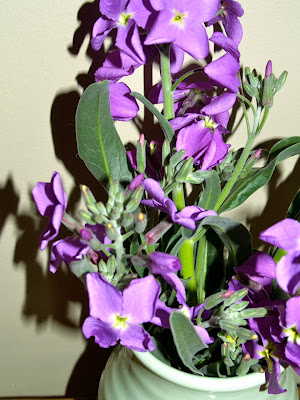For more information on plants featured here phone Ian on 0412 123 240 or email nurseryflorez@gmail.com Mailing Address: Post Office Box 143 Berkeley NSW 2506 Australia
Wednesday, July 28, 2010
Plant pathology:Cercospora leaf spot on Beets
Plant pathology:Black rot on cruciferous vegetables
Xanthomonas campestris
This is a fairly common disease and is spread by dirty water splashing on the leaves from a nearby path or by insects as they move from plant to plant. It is more serious on seedlings as the entire plant may wilt and die especially if they are planted too close together. As it may be bought in to a garden on diseased seed it is important to buy seed from a reliable source. On older plants such as this one, it is first noticed on the edge of the leaves where bacteria can gain entry more easily. Crop rotation is an important part of disease control as well as the removal of related weeds such as wild radish and shepherd's purse. All infected leaves should be removed after harvest and not put into compost.
Plant pathology:Lettuce necrotic yellows
My Italian neighbour at the community garden lets the weed, milk or sow thistle (Sonchus oleraceus) establish itself in a small patch. It is a common and cosmopolitan weed found in many parts of the world. In Italy it is valued as a vegetable to cook with Spaghetti. However, the thistle aphid Hyperomyzus lactucae is the vector for a viral disease which causes lettuce to become stunted with lopsided growth and with many yellow leaves.The aphid is common in autumn around the time this lettuce seedling was planted.
Matthiola incana, Stocks
 Matthiola incana 'Giant Imperial Stock'
Matthiola incana 'Giant Imperial Stock'
You know the days must be getting longer when the sweetly scented Stocks start to flower. This is supposed to be a double flowering form but as the double flower is a recessive gene the percentage of single flowering ones is often high. I prefer the single ones because I think the perfume is stronger and you can sometimes get 2 years out of a plant if you cut off the flowering stems in late Spring. It is worth saving the seed also as next years crop will include some double flowers. Double flowering plants don't set seed. This is a great cut flower with a good vase life but being in the cabbage family, the vase water turns putrid after a couple of days if you don't change it. It is a native of south west Europe.

Tuesday, July 27, 2010
Cineraria multiflora
Saturday, July 24, 2010
Plant pathology:Leaf spot diseases on Rhubarb
Plant pathology:Leaf spot disease on Shasta daisy
Tuesday, July 20, 2010
Pyrenees Flowers
Monday, July 19, 2010
Grevillea 'Flamingo'
 Grevillea Flamingo is just starting to flower and as the bright pink buds open, the weight of the nectar in the blooms draws them down so they resemble a Flamingo feeding.
Grevillea Flamingo is just starting to flower and as the bright pink buds open, the weight of the nectar in the blooms draws them down so they resemble a Flamingo feeding.When I think of Flamingos, I associate them with the Kensington Roof Gardens in central London at the old Derry and Tom's Department store in Kensington High Street. After Derry and Tom's closed, the Art Deco inspired fashion store Biba opened there in the mid 1970's and the Flamingo image was part of that "Golden Age of Hollywood", 1920's and 30's revival. Sadly it has also long gone but four Chilean Flamingos still reside in the 1.5 acre garden that is now owned by Sir Richard Branson.
Saturday, July 17, 2010
The Berkeley Prawn
2017 update: RIP the Berkeley prawn sadly removed because of O H & S issues.
Friday, July 16, 2010
Euphorbia tirucalli 'Firesticks'
Tuesday, July 13, 2010
A mid-winter afternoon
Wednesday, July 7, 2010
Monday, July 5, 2010
NAIDOC Week 4-11 July
Sunday, July 4, 2010
Koi
Subscribe to:
Posts (Atom)



.jpg)




